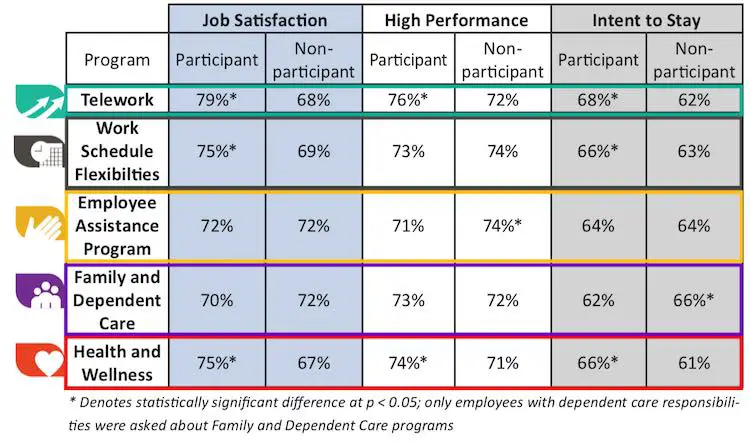The Office of Personnel Management recently published the results of its first ever work-life survey. The study asked federal employees about their experiences with telework, work schedule flexibilities, employee assistance programs, family and dependent care programs, and worksite health and wellness programs.
The study was sent to 196,489 employees, 64,474 of whom responded (37% response rate). It took place from January 25 to March 10, 2017.
In general, the study found that federal employees who used work-life programs reported greater job satisfaction than those who do not. The results showed, for instance, that employees engaging in these programs were more likely to be satisfied with their jobs and expressed greater intentions to remain at their agencies.
Employees utilizing these programs were also significantly more likely to receive a rating of “exceeds fully successful” or higher on their last performance appraisal than those who do not.
The table below from the OPM report captures an overall summary of the findings:
Among the programs in which employees reported the greatest satisfaction were work schedule flexibilities (80%), telework (76%), and employee assistance programs (60%), but considerably less satisfaction was reported with health and wellness programs (38%) and family and dependent care programs (30%).
There was also a strong desire to utilize work-life programs among employees. 96% indicated a desire to use one or more work-life programs, highlighting the importance of offering a variety of work-life programs and understanding the specific needs of employees.
One of greatest barriers found by the study to successful work-life program utilization was support from supervisors. The majority of employees (82%) perceive their immediate supervisor as responsive to and understanding of employees’ personal needs, yet only about half of employees (46%) indicate they experience positive supervisory support for the use of work-life programs.
Next Steps
As for where to go from here based on the survey results, OPM said it intends to do some of the following as next steps:
- Create governmentwide training and toolkits for Federal supervisors and leaders on the value and specifics of work-life programs
- Develop information for work-life coordinators on how to develop, implement, and evaluate their programs using metrics for each of the main work-life program areas – dependent care, health and wellness, telework, and employee assistance program (EAP). OPM will highlight how metrics can be used to track program usage and cost-benefits.
- Continue to highlight and share agency work-life best practices through OPM-hosted forums and webinars
- Develop a guide highlighting agency work-life promising practices by program area: telework, EAP, health and wellness, and dependent care
2018 Federal Work Life Survey Results by FedSmith Inc. on Scribd




